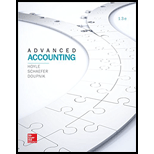
a.
Find the minimum revenue amount which any one segment must generate to be of significant size to require disaggregated disclosure.
a.
Answer to Problem 36P
The minimum revenue amount which any one segment must generate to be of significant size to require disaggregated disclosure is $420,000.
Explanation of Solution
Calculate total revenue of all segments individually
| Red | Blue | Green | Pink | Black | White | |
| Sales to outside parties | $ 1,811 | $ 812 | $ 514 | $ 309 | $ 121 | $ 99 |
| Intersegment revenues | $ 16 | $ 91 | $ 109 | –0– | $ 16 | $ 302 |
| Total | $ 1,827 | $ 903 | $ 623 | $ 309 | $ 137 | $ 401 |
Table: (1)
Calculate total amount of revenue for all the segments
Calculate minimum threshold
Thus, minimum threshold is $420,000
Segments having revenue more than $420,000 are to be disclosed. These are red, blue and green.
b.
Determine is company F disclosing disaggregated data for enough segments.
b.
Answer to Problem 36P
Yes, company F is disclosing disaggregated data for enough segments.
Explanation of Solution
Calculate total sales for the company
Calculate total sales for the three segments
Calculate percentage of sales that the segment represents over the total sales
Thus, percentage of sales is 85.57%
The three segments must have 75% or more of total sales of the company. In this case, it is 85.5%. Hence, the three segments make up 85.6% of total sales of the company.
c.
Find the volume of revenues that must a single customer generate to necessitate disclosing the existence of a major customer.
c.
Answer to Problem 36P
The volume of revenues that must a single customer generate to necessitate disclosing the existence of a major customer is $366,600.
Explanation of Solution
Major customer disclosure is based on total sales; it is 10% of total sales. Total sales are calculated in previous sub-part as $3,666,000.
Calculate major customer disclosure
Thus, major customer disclosure is $366,600
d.
Find which segment warrants separate disclosure if each of these six segments has a profit or loss.
d.
Answer to Problem 36P
Segments red, blue, green and white warrants separate disclosure if each of these six segments has a profit or loss.
Explanation of Solution
Calculate total profits and loss
| Profit | Loss | |
| Red | $ 1,074 | |
| Blue | $ 449 | |
| Green | $ 140 | |
| Pink | $ (94) | |
| Black | $ (222) | |
| White | $ 308 | |
| Total | $ 1,971 | $ (316) |
Table: (2)
Profit is more, hence profit is used to calculate threshold.
Calculate minimum threshold
Thus, minimum threshold is $197,100
Segment having profit more than 10% of profits is to be disclosed. These are red, blue, green and white.
Want to see more full solutions like this?
Chapter 8 Solutions
Soft Bound Version for Advanced Accounting 13th Edition
- Provide correct solution and accounting questionarrow_forwardDescribe any one threat/risk in either the revenue cycle (i.e., in sales and cash collection activities) or the expenditure cycle (i.e., in purchases or cash disbursement activities)arrow_forwardNeed help with this accounting question not use aiarrow_forward
- Principles of Accounting Volume 1AccountingISBN:9781947172685Author:OpenStaxPublisher:OpenStax CollegeCentury 21 Accounting Multicolumn JournalAccountingISBN:9781337679503Author:GilbertsonPublisher:Cengage
 Intermediate Accounting: Reporting And AnalysisAccountingISBN:9781337788281Author:James M. Wahlen, Jefferson P. Jones, Donald PagachPublisher:Cengage Learning
Intermediate Accounting: Reporting And AnalysisAccountingISBN:9781337788281Author:James M. Wahlen, Jefferson P. Jones, Donald PagachPublisher:Cengage Learning Financial Reporting, Financial Statement Analysis...FinanceISBN:9781285190907Author:James M. Wahlen, Stephen P. Baginski, Mark BradshawPublisher:Cengage Learning
Financial Reporting, Financial Statement Analysis...FinanceISBN:9781285190907Author:James M. Wahlen, Stephen P. Baginski, Mark BradshawPublisher:Cengage Learning




